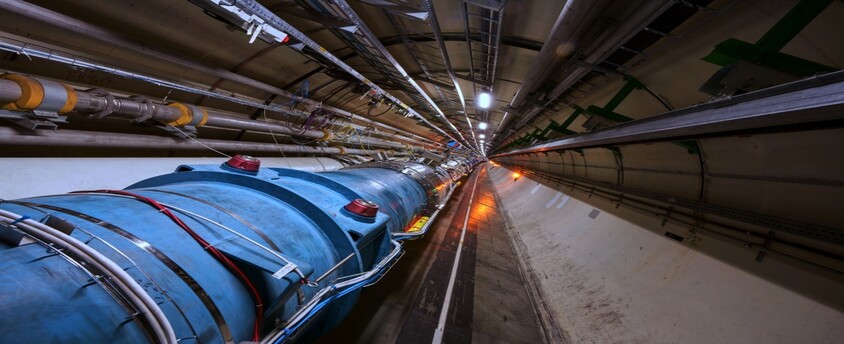Large Hadron Collider
15, Apr 2023

Prelims level : Science & Technology
Mains level : GS-III Science & Technology Art Culture | Awareness In The Fields Of It, Space, Computers, Robotics, Nano-Technology, Bio-Technology, Pharma Sector & Health Science
Why in News?
- The Large Hadron Collider (LHC) is the world’s largest and most powerful particle accelerator.
- It is also regarded as one of the world’s largest science experiments.
- LHC is a collider that accelerates two beams of particles in opposite directions and smashes them head-on.
- These beams of particles are Hadrons.
- Hadron is a subatomic particle made of quarks, gluons and anti-quarks.
- Hadrons are the heaviest particles and are composed of two or more quarks that are held strongly by electromagnetic force.
- LHC is built by the European Organization for Nuclear Research (CERN).
Functioning of Large Hadron Collider:
- The LHC uses Protons, which are made up of quarks and gluons and it energises the protons by accelerating them through a narrow circular pipe that is 27 km long.
- This circular pipe encircles two D-shaped magnetic fields, created by close to 9,600 magnets.
- In the pipe, Protons are made to move by turning on one hemisphere of magnets and turning off the other and once it reaches a specific position the magnetic polarity is reversed by turning off the first hemisphere and turning on the second.
- This makes the Proton move in an anticlockwise direction and by switching the direction of the magnetic field rapidly, Protons are accelerated through the beam pipe.
- There are a few other components placed in the pipe that ensure that the particles do not hit the pipe’s walls.
- This process makes the Protons move at 99.999999% of the speed of light which helps them accrue a tremendous amount of energy as per the special theory of relativity.
- When two antiparallel beams of energised particles collide head-on, the energy at the point of collision is equal to the sum of the energy carried by the two beams.
- At the time of the collision, chaos is witnessed and parts of energy coalesce into different subatomic particles based on the fundamental forces of nature.
- The particles take shape depending on the amount and flavour of energy available and which other particles are being created or destroyed around them.
- A few particles are created very rarely i.e. are created with a probability of 0.00001%.
- A few other particles are quite massive and require the right kind of energy to be created.
- A few other particles are extremely short-lived and the detectors studying them need to record them in a similar timeframe.The LHC is built in such a way that scientists can alter all these parameters to study different particle interactions.
The Findings of the LHC:
- The LHC has nine detectors that are placed at different points on the beam pipe. These detectors are used to study particle interactions in different ways.
- Annually, these detectors generate close to 30,000 TB of data worth storing, Physicists filter this data with the help of computers to identify and analyse specific patterns.
- This is similar to how the ATLAS and CMS detectors helped discover the Higgs boson.
- The LHC is known for accelerating a beam of hadronic particles to certain specifications and delivering it which facilitates scientists to do different things with the beam.
- With the help of data generated from all these collisions, researchers have tested the predictions of the Standard Model of particle physics, the reigning theory of subatomic particles, observed exotic particles such as pentaquarks and tetraquarks and examined the extreme natural conditions that existed right after the Big Bang.
Path ahead:
- LHC has to date failed to find “new physics”, which is the collective name for particles or processes that can explain the nature of dark matter or why gravity is such a weak force, and other mysteries.
- Efforts are underway to enhance LHC’s luminosity which is a measure of the machine’s ability to produce particle interactions of interest.
- There is a controversial idea to develop a bigger version of the LHC as it is believed that such a machine will be able to find “new physics” at higher energies.
- As CERN and China have announced their plans to develop bigger machines, the scientific community is divided on the use of billions of dollars. Few experts argue that money can be used to build less-expensive equipment such as colliders, with guaranteed outcomes instead of speculative results.






